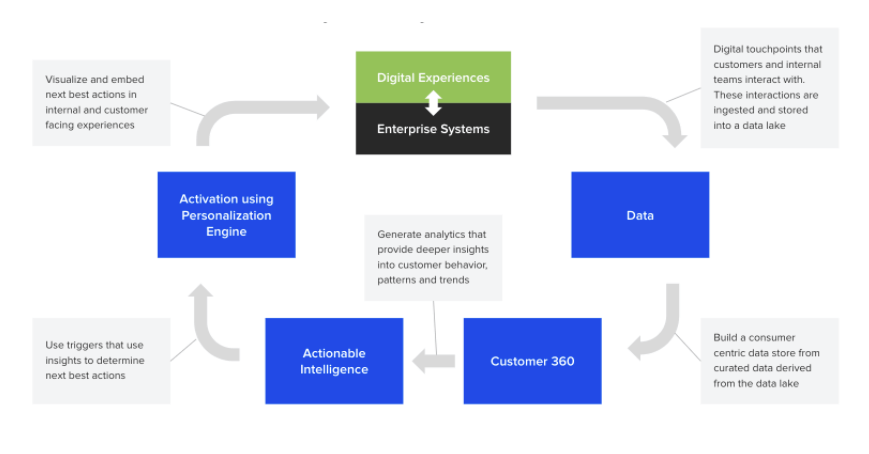The modern customer highly values personalization and wants companies to understand them and tailor their products, services, and customer service efforts accordingly.
Companies are embracing customer experience (CX) and customer-centricity as a critical pillar of their digital transformation strategy:
- To better understand customer wants, needs, and motivations.
- To better respond with personalized products and services.
- To offer superior customer service.
- To adopt operating models that remove friction from the customer experience.
- To better align their digital marketing strategy.
Being customer-centric includes creating and acting upon a comprehensive understanding of customers’ motivations, desires, and wants that can help improve customer satisfaction, loyalty, and advocacy. These are key parts of a CX strategy.
Customer data and a company’s ability to convert data into actionable insights are crucial components of delivering customer-centric experiences.
Think of generating and using customer analytics as a lifecycle, as shown in the image below:

A Customer 360 view for your digital transformation in customer experience all starts with a Customer 360 database.
What is a Customer 360 Database?
A Customer 360 database aggregates data about customer interactions across various points throughout the entire customer journey.
Examples of core types of data that a Customer 360 view should aggregate for a particular customer include:
- Behavioral (response to specific campaigns, mobile app usage patterns etc)
- Social listening
- Preferences
- Voice of the customer (surveys)
- Interactions across key engagement channels like social, web, email, mobile, customer care/support
- Core transactions across various enterprise systems
- Customer Segmentation
- First party demographic data
- Second and third party data if available
- and more…
Customer analytics use Customer 360 aggregated data to create actionable insights that are used to generate personalized actions, next best actions, suggestions, and notifications.
Customer 360 Use Cases
Customer 360 data can be converted into actionable insights like:
- What segment does this person belong to and has the segment changed?
- Do we recognize this person?
- If this is a customer, then has their demographic situation changed?
- Do they qualify for an offer? If so, which one?
- What are this person’s preferences, and what content would most likely make them act?
- What is the person’s past purchase history, and what does it say about future transactions?
- What cross-sell and upsell opportunities apply to this customer?
- What does their search history on the website suggest about their product preferences?
- Does retargeting work on a customer?
In turn, customer analytics can be leveraged to trigger personalized actions across channels and business functions – for example:
- For marketing – to target specific actions based on the customer’s interaction with content on the website.
- For customers – when they are interacting with the mobile app.
- For customer service – when speaking to a customer service agent.
- For sales teams- to engage proactively with customers.
- For product teams – to design better products and services.
As discussed, a Customer 360 database and customer analytics play a significant role in a company’s digital transformation journey.
Many tools in your arsenal like a Customer Data Platform (CDP), Cloud Data Lakes, data visualization tools that generate automated insights, a variety of ML platforms and AI tools, etc, can accelerate the creation of your customer 360 view and customer analytics. These tools can also drive the activation of analytics across customer engagement channels.
Productive Edge helps organizations bridge the gap between digital strategy consulting and technology solutions development. As a strategic partner for our clients, we provide enterprise customer experience solutions backed by Big Data and intelligent analytics. Contact us to learn more about how you can get started on delivering personalized experiences to your customers.




